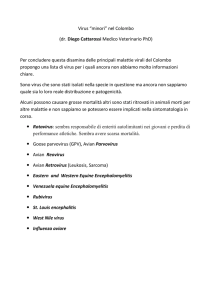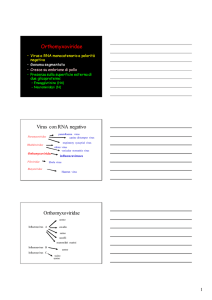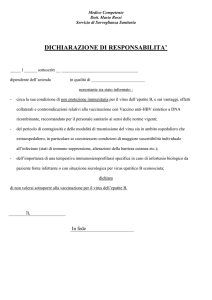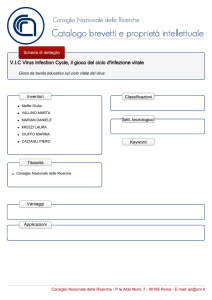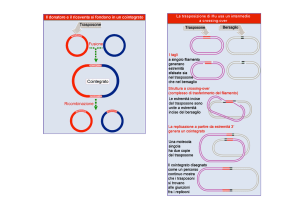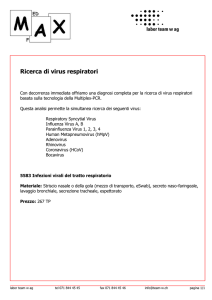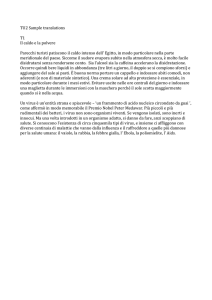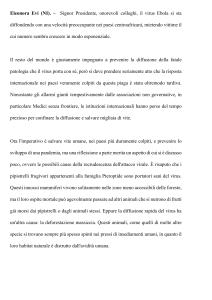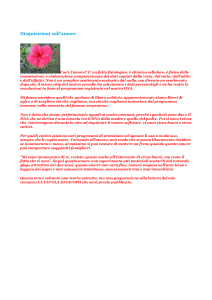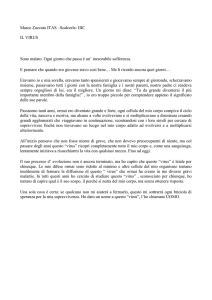Caratterizzazione del virus dell`Influenza Equina A H3N8 isolato in
annuncio pubblicitario
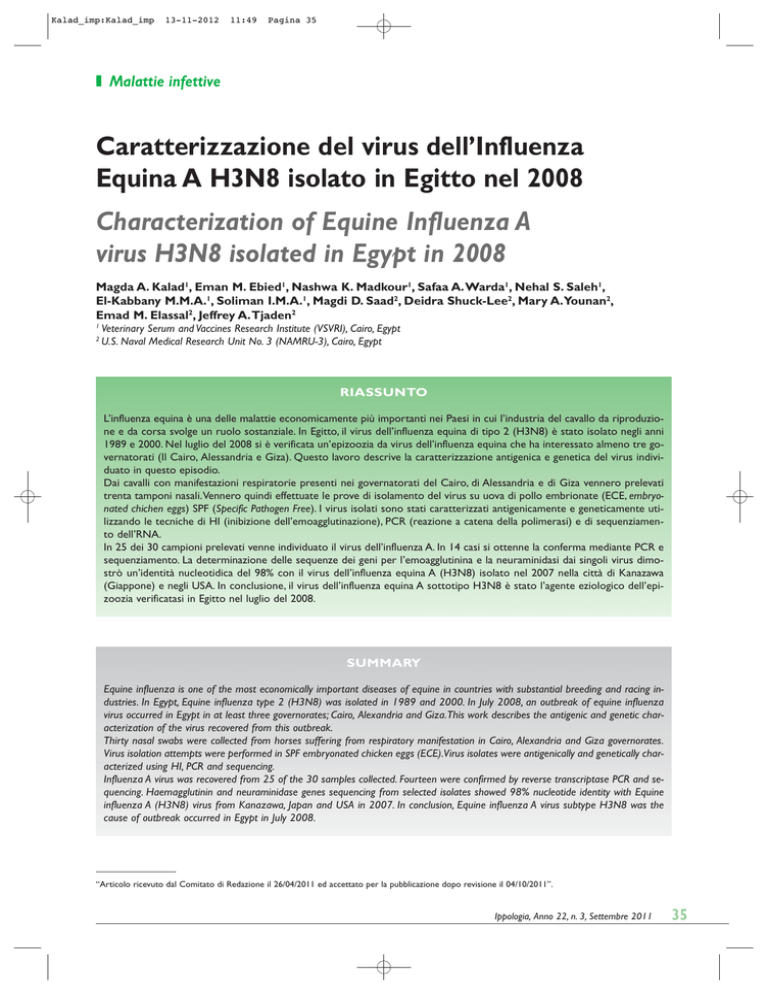
Kalad_imp:Kalad_imp 13-11-2012 11:49 Pagina 35 ❚ Malattie infettive Caratterizzazione del virus dell’Influenza Equina A H3N8 isolato in Egitto nel 2008 Characterization of Equine Influenza A virus H3N8 isolated in Egypt in 2008 Magda A. Kalad1, Eman M. Ebied1, Nashwa K. Madkour1, Safaa A. Warda1, Nehal S. Saleh1, El-Kabbany M.M.A.1, Soliman I.M.A.1, Magdi D. Saad2, Deidra Shuck-Lee2, Mary A. Younan2, Emad M. Elassal2, Jeffrey A. Tjaden2 1 2 Veterinary Serum and Vaccines Research Institute (VSVRI), Cairo, Egypt U.S. Naval Medical Research Unit No. 3 (NAMRU-3), Cairo, Egypt RIASSUNTO L’influenza equina è una delle malattie economicamente più importanti nei Paesi in cui l’industria del cavallo da riproduzione e da corsa svolge un ruolo sostanziale. In Egitto, il virus dell’influenza equina di tipo 2 (H3N8) è stato isolato negli anni 1989 e 2000. Nel luglio del 2008 si è verificata un’epizoozia da virus dell’influenza equina che ha interessato almeno tre governatorati (Il Cairo, Alessandria e Giza). Questo lavoro descrive la caratterizzazione antigenica e genetica del virus individuato in questo episodio. Dai cavalli con manifestazioni respiratorie presenti nei governatorati del Cairo, di Alessandria e di Giza vennero prelevati trenta tamponi nasali. Vennero quindi effettuate le prove di isolamento del virus su uova di pollo embrionate (ECE, embryonated chichen eggs) SPF (Specific Pathogen Free). I virus isolati sono stati caratterizzati antigenicamente e geneticamente utilizzando le tecniche di HI (inibizione dell’emoagglutinazione), PCR (reazione a catena della polimerasi) e di sequenziamento dell’RNA. In 25 dei 30 campioni prelevati venne individuato il virus dell’influenza A. In 14 casi si ottenne la conferma mediante PCR e sequenziamento. La determinazione delle sequenze dei geni per l’emoagglutinina e la neuraminidasi dai singoli virus dimostrò un’identità nucleotidica del 98% con il virus dell’influenza equina A (H3N8) isolato nel 2007 nella città di Kanazawa (Giappone) e negli USA. In conclusione, il virus dell’influenza equina A sottotipo H3N8 è stato l’agente eziologico dell’epizoozia verificatasi in Egitto nel luglio del 2008. SUMMARY Equine influenza is one of the most economically important diseases of equine in countries with substantial breeding and racing industries. In Egypt, Equine influenza type 2 (H3N8) was isolated in 1989 and 2000. In July 2008, an outbreak of equine influenza virus occurred in Egypt in at least three governorates; Cairo, Alexandria and Giza. This work describes the antigenic and genetic characterization of the virus recovered from this outbreak. Thirty nasal swabs were collected from horses suffering from respiratory manifestation in Cairo, Alexandria and Giza governorates. Virus isolation attempts were performed in SPF embryonated chicken eggs (ECE).Virus isolates were antigenically and genetically characterized using HI, PCR and sequencing. Influenza A virus was recovered from 25 of the 30 samples collected. Fourteen were confirmed by reverse transcriptase PCR and sequencing. Haemagglutinin and neuraminidase genes sequencing from selected isolates showed 98% nucleotide identity with Equine influenza A (H3N8) virus from Kanazawa, Japan and USA in 2007. In conclusion, Equine influenza A virus subtype H3N8 was the cause of outbreak occurred in Egypt in July 2008. “Articolo ricevuto dal Comitato di Redazione il 26/04/2011 ed accettato per la pubblicazione dopo revisione il 04/10/2011”. Ippologia, Anno 22, n. 3, Settembre 2011 35 Kalad_imp:Kalad_imp 13-11-2012 11:49 Pagina 36 ❚ Malattie infettive 36 INTRODUZIONE INTRODUCTION Da un centinaio di anni, il Medio Oriente alleva e seleziona una razza pura di cavalli Arabi. L’Egitto era considerato un mercato industriale per il commercio e l’esportazione della razza verso molti Paesi del mondo. È infatti situato nel crocevia di molte attività commerciali ed ha i confini aperti verso numerosi Stati dell’Africa e dell’Asia. Proteggere gli allevamenti dalle malattie esotiche richiede grandi sforzi e un’imponente organizzazione fra le differenti amministrazioni. L’influenza equina (EI) viene considerata una delle più importanti malattie respiratorie nei Paesi in cui l’industria del cavallo da riproduzione e da corsa rappresenta una delle principali attività economiche. I virus dell’influenza A (famiglia Orthomyxoviridae) sono noti come causa di malattia respiratoria acuta nell’uomo, nel cavallo, nel suino e negli uccelli (Webster et al., 1992). Il virus EI presenta due sottotipi distinti: H7N7 (Sovinova et al., 1958) and H3N8 (Wadell et al., 1963). Generalmente si ritiene che il primo non causi epizoozie quanto il secondo, tanto che potrebbe essere estinto dato che l’ultima epizoozia confermata sostenuta da questo virus risale al 1978 (Webster,1993; VanMaanen e A. Cullinane, 2002). Invece, le epizoozie provocate da H3N8 si verificano ogni anno. Uno studio condotto in Colorado nel 1998 ha dimostrato che l’agente patogeno era responsabile di due terzi delle infezioni virali respiratorie degli equini (Mumford et al.,1998). Tutte le principali epizoozie degli ultimi 20 anni sono state dovute a virus dell’influenza A del sottotipo H3N8, che sembra essere di origine aviare (Janet et al., 2004). Malgrado i programmi di vaccinazione intensiva, l’infezione da H3N8 è rimasta un grave problema sanitario ed economico in tutto il mondo. Alla fine degli anni 1980, venne registrata una grave epizoozia di EI nei cavalli in Sud Africa, in India e nella Repubblica popolare cinese, dove l’esistenza dei virus dell’influenza equina A non era neppure nota. Recentemente, in Egitto, nel 1989, è stata registrata un’epizoozia di EI H3N8 (Ismail et al., 1990; Esmat et al., 1992). Un’altra epizoozia, causata dallo stesso sottotipo virale, era stata riscontrata nel 1999-2000 (Hamoda et al., 2001; Nahwa, 2004). Nel giugno 2008 si osservarono dei casi di malattia caratterizzati da manifestazioni respiratorie nella popolazione equina di Alessandria, del Cairo e di Giza. I principali segni clinici osservati erano rappresentati da tosse frequente, aspra e secca, spesso accompagnata da febbre elevata. Dai casi sospetti furono prelevati dei tamponi nasali che vennero conservati a -80°C fino all’impiego per l’isolamento e l’identificazione del virus. Nell’ambito di questo studio, gli autori hanno cercato di isolare e caratterizzare l’agente eziologico responsabile di questa epizoozia. Since a century, the Middle East keeps a pure breed of Arabian horses. Egypt was considered as an industrial market for trade and export of the breed to many countries. Egypt is located at the cross road of many trades with open borders with different countries in Africa and Asia. Protecting live stock from exotic diseases takes a lot of effort and organization between different administrations. Equine influenza (EI) is considered to be one of the most important respiratory diseases in equine in countries where the breeding and racing of horses is a major industry. Influenza A viruses (family orthomyxoviridae) are known to cause acute respiratory disease in human, horses, pigs and birds (Webster et al., 1992). EI virus has 2 distinct subtypes: H7N7 (Sovinova et al., 1958) and H3N8 (Wadell et al., 1963). It is generally accepted that the former does not cause outbreaks as much as the latter, since may be extinct the last confirmed outbreak caused by this virus was in 1978 (Webster,1993; VanMaanen and A. Cullinane, 2002), However, outbreaks by H3N8 occur annually. A study conducted in Colorado in 1998 showed that the pathogen was responsible for two thirds of equine viral respiratory infection (Mumford et al., 1998). All major equine outbreaks in the past 20 years were due to Influenza A viruses of the H3N8 subtype which appears to be of avian origin (Janet et al., 2004). Despite intensive vaccination programs, EI H3N8 infection has remained a serious health and economic problem throughout the world. In the late 1980s, severe widespread EI outbreaks were recorded in horses in South Africa, India and the People’s Republic of China where equine influenza A viruses were not known to exist. Recently in Egypt, in 1989, an outbreak of EI H3N8 was recorded (Ismail et al.,1990; Esmat et al., 1992). Another outbreak, caused by the same subtype, was recorded in 1999-2000 (Hamoda et al., 2001; Nahwa, 2004). In June, 2008, cases with respiratory manifestations were observed among equine population in Alexandria, Cairo and Giza. The most prominent clinical signs observed were: frequent harsh dry coughing often accompanied with high fever. Nasal swab samples were collected from the suspected cases and stored at -80oC until processed for virus isolation and identification. In this study we attempted to isolate and characterize the causative agent responsible for this outbreak. Caratterizzazione del virus dell’Influenza Equina A H3N8 isolato in Egitto nel 2008 MATERIALS & METHODS Samples A total of 30 nasal swab samples were collected on viral transfer media by the General Organization for Veterinary Services (GOVS) of Egypt. Samples were collected from horses of different ages and breeds Kalad_imp:Kalad_imp 13-11-2012 11:49 Pagina 37 ❚ Malattie infettive MATERIALI E METODI Campioni Attraverso l’Organizzazione Generale dei Servizi Veterinari (GOVS, General Organization for Veterinary Services) dell’Egitto sono stati raccolti in totale 30 tamponi nasali, inseriti in appositi terreni per il trasporto dei virus. I campioni sono stati prelevati da cavalli di età e razza differenti (12 dal governatorato di Alessandria, 12 da quello del Cairo e 6 da quello di Giza) (Figura 1, mappa dell’Egitto) e poi inviati all’Equine Diseases Research Department at the Veterinary Serum and Vaccine Research Institute (VSVRI) del Cairo, in Egitto, per l’isolamento e l’identificazione del virus. (12 from Alexandria, 12 from Cairo and 6 from Giza governorates) (Figure 1, Map of Egypt). Samples were sent to the Equine Diseases Research Department at the Veterinary Serum and Vaccine Research Institute (VSVRI), Cairo, Egypt for virus isolation and identification. Isolamento del virus Nella cavità amnio-allantoidea di uova di pollo embrionate (ECE) di 9-11 giorni di età ed indenni da agenti patogeni specifici (SPF, Specific pathogen free) venne inoculato un volume di 0,2 ml di ciascun campione clinico. Le ECE vennero incubate a 3435°C per tre giorni e poi conservate a 4°C per 24 ore prima di essere sottoposte al prelievo del liquido amnio-allantoideo. Si determinò quindi l’attività emoagglutininica nel liquido purificato, impiegando il test di emoagglutinazione (HA) (Palmer et al., 1975; OIE, 2004). I liquidi prelevati dalle uova che presentavano un’attività HA < 1/16 o non mostravano alcuna prova della presenza del virus dell’EI vennero reinoculati sino ad un massimo di altre tre volte in ECE SPF e poi riesaminati. Il liquido prelevato dalle uova con un titolo di HA ≥ 1/16 venne sottoposto ad identificazione mediante test di inibizione dell’emoagglutinazione (HI) utilizzando antisieri sottotipo-specifici (Swenson, 1992; OIE, 2004). Identificazione degli agenti virali isolati: test di emoagglutinazione (HA) e inibizione dell’emoagglutinazione (HI) I test HA ed HI utilizzati per l’identificazione dell’agente virale isolato (liquidi delle uova al secondo ed al terzo passaggio) vennero effettuati utilizzando una sospensione di eritrociti di pollo all’1% ed antisieri di riferimento attivi sia contro il sierotipo (A/equi-1) che quello (A/equi-2). Vennero utilizzati antisieri di riferimento provenienti dal National Veterinary Services Laboratories, USA Department of Agriculture veterinary services (NVSL., USDA) (OIE, 2004). PCR e sequenziamento L’RNA del virus venne estratto dagli isolati virali raccolti utilizzando il Qiagen viral RNA mini kit (Qiagen Inc., CA, USA) seguendo le istruzioni della casa produttrice. L’RNA è stato esaminato utilizzando una tecnica di PCR in tempo reale specifica per la matrice genica dei virus dell’influenza A, secondo le indicazioni di (Spackman et al., 2002). L’RNA degli isolati risultati positivi per la matrice genica è stato FIGURA 1 - Mappa dell’Egitto che mostra i governatorati in cui si sono verificate le epizoozie di EI nel 2008. FIGURE 1 - Map of Egypt showing governorates where EI outbreak occurred in 2008. Virus isolation A volume of 0.2 ml from each clinical sample was inoculated into amnio-allantoic cavity of a 9-11 day old Specific pathogen free (SPF) Embryonated chicken eggs (ECE). ECE were incubated at 34- 35oC for three days and then stored at 4oC overnight before amnioallantoic fluid was harvested. HA activity in the clarified fluid was determined using haemagglutination test (HA) (Palmer et al., 1975,OIE., 2004). Harvested egg fluids which had either HA activity < 1/16 or lacking evidence of EI virus were re-inoculated up to 3 more times in SPF ECE and evaluated. Harvested egg fluid with HA titer ≥ 1/16 were identified by haemagglutination inhibition (HI) test using subtype specific antisera (Swenson, 1992; OIE, 2004). Identification of the isolated viral agents: Haemagglutination (HA) & Haemagglutination inhibition (HI) test HA and HI tests used for identification of the isolated viral agent (Egg fluids of the 2nd and 3rd passages) were performed using 1% chicken RBCs suspension Ippologia, Anno 22, n. 3, Settembre 2011 37 Kalad_imp:Kalad_imp 13-11-2012 11:49 Pagina 38 ❚ Malattie infettive impiegato per la trascrizione inversa dei segmenti del virus dell’influenza A utilizzando il primer universale “Uni-12” secondo le indicazioni di Hoffman et al., 2001. Il cDNA ottenuto da quest’ultimo passaggio venne impiegato per l’amplificazione dei geni per la codifica dell’emoagglutinina e della neuraminidasi, mediante l’uso dei set di primer universali sviluppati da Hoffman et al., 2001. I prodotti dell’amplificazione dei geni della HA e della NA vennero sequenziati utilizzando il BigDye terminator kit versione 3.1 della Applied Biosystems, CA, USA, seguendo le istruzioni della casa produttrice e i dati vennero letti mediante ABI3130xl Genetic Analyzer. Analisi della sequenza genica Le sequenze dei geni per l’emoagglutinina (HA) e la neuroaminidasi (NA) sono state editate impiegando il Sequencher software (Gene Codes, Inc., USA) e confrontati con le sequenze strettamente correlate disponibili presso la GenBank, utilizzando il BioEdit software, versione 7.0.9. (Hall T.A., 1999). L’analisi delle evoluzioni delle sequenze sia dal punto di vista filogenetico che molecolare venne condotta utilizzando il MEGA versione 5 (Tamura, Peterson, Stecher, Nei, Kumar 2011). I modelli evolutivi più adatti a ciascun set di dati (sia per l’HA che per la NA) vennero stimati utilizzando la funzione di test del modello di MEGA5 seguendo i criteri di default del software. Vennero ricostruiti gli alberi di massima probabilità per ciascun allineamento di sequenza di HA ed NA utilizzando il modello evolutivo più adatto stabilito nel corso del passaggio precedente. Le sequenze geniche per HA ed NA sono state inviate alla GenBank utilizzando, rispettivamente, i numeri di accesso FJ209731 ed CY087167. RISULTATI E DISCUSSIONE L’insorgenza improvvisa e la rapida diffusione in tutte le categorie di età osservata attraverso la comparsa di tosse frequente e aumento della temperatura corporea portarono alla formulazione di un sospetto diagnostico di influenza equina, che è considerata la più importante malattia respiratoria contagiosa degli equini a carattere transitorio (Wilson, 1993; Daly et al., 2006). L’introduzione di un singolo cavallo infetto da EI può determinare una diffusione esplosiva del virus fra gli equini non protetti su un’ampia area geografica; ciò deve imporre la cancellazione delle competizioni dei cavalli da corsa per 5 mesi, l’interruzione dei programmi di allenamento ed occasionalmente la cancellazione di un torneo, con conseguenti perdite economiche (Newton e Mumford, 1995; Guthrie et al., 1999; OIE, 2004). Dal 1978, i virus dell’influenza equina A H7N7 non hanno più provocato epizoozie note e non sono più considerati una causa importante di malattia respiratoria nei cavalli (Webster, 1993; Van Maanen e A. Cullinane 2002, OIE, 2004). 38 Caratterizzazione del virus dell’Influenza Equina A H3N8 isolato in Egitto nel 2008 and reference antisera against both (A/equi-1) and (A/equi-2). Reference antisera obtained from National Veterinary Services Laboratories, USA Department of Agriculture veterinary services (NVSL., USDA) were used (OIE, 2004). PCR and sequencing Viral RNA was extracted from harvested virus isolates using Qiagen viral RNA mini kit (Qiagen Inc., CA, USA) according to manufacturer’s instructions. RNA was tested using real time PCR assay specific for the matrix gene of influenza A viruses according to (Spackman et al., 2002). RNA from isolates that were positive for the matrix gene were used for reverse transcription of influenza A virus segments using “Uni-12” universal primer according to Hoffman et al., 2001. cDNA from the latter step was used for amplification of the haemagglutinin and neuraminidase genes using the universal primer sets developed by Hoffman et al., 2001. Amplified products of HA and NA genes were sequenced using the BigDye terminator kit version 3.1 from Applied Biosystems, CA, USA, according to manufacturer instructions on the ABI3130xl Genetic Analyzer. Sequence analysis Sequences of haemagglutinin (HA) and neuraminidase (NA) genes were edited using the Sequencher software (Gene Codes, Inc., USA) and aligned with closely related sequences available in GenBank using the BioEdit software version 7.0.9. (Hall, T.A. 1999). Phylogenetic and molecular evolutionary analyses were conducted using MEGA version 5 (Tamura, Peterson, Stecher, Nei, Kumar 2011). Evolutionary model best fit for each data set (HA or NA) was estimated using the model test function in MEGA5 following the software default criteria. Maximum likelihood trees were reconstructed for each of HA and NA sequence alignment using the best fit evolutionary model from the previous step. HA and NA sequences were submitted to GenBank under accession numbers: FJ209731 and CY087167 respectively. RESULTS AND DISCUSSION The sudden onset, rapid spread of infection in all age categories observed through frequent coughing and elevated body temperatures led to a tentative clinical diagnosis of Equine influenza, which is considered to be the most important transient, contagious, respiratory disease of horses (Wilson, 1993; Daly et al., 2006). Introduction of a single infected horse with EI can result in explosive virus spread in unprotected horses over a wide geographical area; this would necessitate cancellation of racing competitions for 5 months, interruption in training programs and occasional tournament disruption leading to economic losses (Newton and Mumford, 1995; Guthrie et al., 1999; OIE, 2004). Kalad_imp:Kalad_imp 13-11-2012 11:49 Pagina 39 ❚ Malattie infettive In Egitto, nell’ottobre del 1989 e all’inizio del 2000 vennero rilevate due epizoozie di influenza nella popolazione equina; nella prima furono individuati i sottotipi 1 e 2, mentre nella seconda fu riscontrato soltanto il sottotipo 2. Nel giugno 2008, nella popolazione equina dei governatorati di Alessandria, del Cairo e di Giza si osservarono dei casi di manifestazioni respiratorie simili a quelle descritte nelle epizoozie precedenti (Figura 1). Gli accertamenti clinici seguiti dai tentativi di isolare il virus dai campioni prelevati dagli animali colpiti permisero di identificare l’EI come agente eziologico di questa epizoozia. Il virus dell’influenza A sottotipo H3N8 venne isolato da 25 tamponi nasali su 30 (83,3%). Questa è Since 1978, equine influenza A H7N7 viruses have not caused any known outbreaks, and are no longer considered an important cause of respiratory disease in horses (Webster, 1993; Van Maanen and A. Cullinane 2002; OIE, 2004). In Egypt, two outbreaks of equine influenza among equine populations were recorded in October (1989) and in the beginning of (2000), both subtypes 1 and 2 were detected in the first outbreak and only type 2 in the second. In June (2008), cases of respiratory manifestation were observed among equine population in Alexandria, Cairo and Giza governorates similar to those observed in the previous outbreaks (Figure 1). TABELLA 1 Passaggi e titoli di HA in uova di pollo embrionate (ECE) inseminate con tamponi nasali equini Località Cairo Alessandria Giza Numero di serie dei tamponi nasali Passaggi 1° passaggio 2° passaggio 3° passaggio +ve/T +ve/T range del titolo HA +ve/T range del titolo HA +ve/T range del titolo HA 1 3/5 * * 8-16 5/5 8-128 * ND ND 2 2/5 2 5/5 32 ND ND 3 3/5 8-16 4/5 16-32 ND ND 4 0/5 -ve 4/5 8-128 ND ND 5 0/5 -ve 4/5 4-16 ND ND 6 0/5 -ve 0/5 -ve 0/5 -ve 7 3/5 8-16 5/5 32-64 ND ND 8 0/5 -ve 4/5 32-128 ND ND 9 0/5 -ve 4/5 4-16 ND ND 10 0/5 -ve 4/5 64 ND ND 11 1/5 2 3/5 32 ND ND 12 2/5 4 4/5 8-16 ND ND 1 1/5 2 0/5 16 ND ND 2 2/5 2 5/5 32-128 ND ND 3 2/5 2 5/5 32-64 ND ND 4 0/5 -ve 0/5 -ve 0/5 -ve 5 0/5 -ve 2/5 8 4/5 16 6 0/5 -ve 2/5 8 4/5 16 7 0/5 -ve 5/5 128-256 ND ND 8 0/5 -ve 0/5 -ve 0/5 -ve 9 0/5 -ve 0/5 -ve 0/5 -ve 10 0/5 -ve 5/5 128-256 ND ND 11 2/5 4-8 4/5 64- 128 ND ND 12 1/5 4 3/5 16-32 ND ND 1 2/5 2-8 5/5 32-128 ND ND 2 0/5 -ve 2/5 8-16 ND ND 3 0/5 -ve 3/5 8-16 ND ND 4 0/5 -ve 0/5 -ve 0/5 -ve 5 2/5 -ve 2/5 8-16 ND ND 6 1/5 4 2/5 8-16 ND ND +ve/T = Positivi / Uova totali - * ND = Non effettuato -ve = negativi - ** Il titolo HA è espresso come reciproco della diluizione virale Ippologia, Anno 22, n. 3, Settembre 2011 39 Kalad_imp:Kalad_imp 13-11-2012 11:49 Pagina 40 ❚ Malattie infettive TABLE 1 Passage level and HA titers of equine nasal swabs in Embryonated Chicken Egg (ECE) Locality Cairo Alex Giza Serial number of nasal swabs Passages st nd 1 passage 3rd passage 2 passage +ve/T +ve/T HA titer range +ve/T HA titer range +ve/T HA titer range 1 3/5 * * 8-16 5/5 8-128 * ND ND 2 2/5 2 5/5 32 ND ND 3 3/5 8-16 4/5 16-32 ND ND 4 0/5 -ve 4/5 8-128 ND ND 5 0/5 -ve 4/5 4-16 ND ND 6 0/5 -ve 0/5 -ve 0/5 -ve 7 3/5 8-16 5/5 32-64 ND ND 8 0/5 -ve 4/5 32-128 ND ND 9 0/5 -ve 4/5 4-16 ND ND 10 0/5 -ve 4/5 64 ND ND 11 1/5 2 3/5 32 ND ND 12 2/5 4 4/5 8-16 ND ND 1 1/5 2 0/5 16 ND ND 2 2/5 2 5/5 32-128 ND ND 3 2/5 2 5/5 32-64 ND ND 4 0/5 -ve 0/5 -ve 0/5 -ve 5 0/5 -ve 2/5 8 4/5 16 6 0/5 -ve 2/5 8 4/5 16 7 0/5 -ve 5/5 128-256 ND ND 8 0/5 -ve 0/5 -ve 0/5 -ve 9 0/5 -ve 0/5 -ve 0/5 -ve 10 0/5 -ve 5/5 128-256 ND ND 11 2/5 4-8 4/5 64- 128 ND ND 12 1/5 4 3/5 16-32 ND ND 1 2/5 2-8 5/5 32-128 ND ND 2 0/5 -ve 2/5 8-16 ND ND 3 0/5 -ve 3/5 8-16 ND ND 4 0/5 -ve 0/5 -ve 0/5 -ve 5 2/5 -ve 2/5 8-16 ND ND 6 1/5 4 2/5 8-16 ND ND +ve/T = Positive / Total eggs - * ND = Not Done -ve = negative - * * HA titer expressed as the reciprocal of the virus dilution una percentuale proporzionalmente elevata; per esempio, Marley et al.,1995 riferirono soltanto una positività del 7% di isolamento del virus da estratti di tamponi nasali prelevati da cavalli con malattia respiratoria acuta nel corso di epizoozie di influenza. Per quanto concerne l’indagine virologica sull’attività emoagglutininica suscitata dai tamponi nasali nelle ECE, la Tabella 1 evidenzia che 25 isolati su 30 al primo passaggio (13 isolati, 6 da cavalli provenienti dal Cairo, 5 da Alessandria e 2 da Giza) e 12 isolati al secondo passaggio (5 dal Cairo, 4 da Alessandria e 3 da Giza) hanno fatto riscontrare titoli compresi, rispettivamente, tra 216 e 8-256. 40 Caratterizzazione del virus dell’Influenza Equina A H3N8 isolato in Egitto nel 2008 Clinical investigations followed by virus isolation attempts from samples collected from affected horses were successful in identifying EI as the causative agent for this outbreak. Influenza A, H3N8 subtype virus was isolated from 25 of 30 (83.3%) nasal swabs. This is a comparatively high percentage, for example Marley et al., 1995 reported 7% positive virus isolation from nasal swabs extracts obtained from horses with acute respiratory disease during influenza epidemics. With regard to virological investigation of nasal swabs yielding haemagglutinating activity in ECE; Table 1 shows that 25 of 30 isolates from the first passage (13 isolates; 6 from Cairo, 5 from Alex and 2 from Giza) and 12 isolates Kalad_imp:Kalad_imp 13-11-2012 11:49 Pagina 41 ❚ Malattie infettive TABELLA 2 Identificazione sierologica degli agenti virali isolati utilizzando il test HI Località Cairo Aless. Giza Numero del campione **Titolo *Titolo HI degli antisieri antiHA A/equi-1 A/equi-2 TABLE 2 Serological identification of the isolated viral agents using HI test Locality Sample number **HA titer *HI titer of Antisera against A/equi-1 A/equi-2 1 128 -ve 320 1 128 -ve 320 2 32 -ve 160 2 32 -ve 160 3 32 -ve 160 3 32 -ve 160 4 128 -ve 320 4 128 -ve 320 5 16 -ve 160 5 16 -ve 160 7 64 -ve 160 8 128 -ve 320 Cairo 7 64 -ve 160 8 128 -ve 320 9 16 -ve 160 9 16 -ve 160 10 64 -ve 160 10 64 -ve 160 11 32 -ve 320 11 32 -ve 320 12 16 -ve 160 12 16 -ve 160 1 16 -ve 160 1 16 -ve 160 2 128 -ve 320 2 128 -ve 320 3 64 -ve 320 3 64 -ve 320 5 64 -ve 160 5 64 -ve 160 6 128 -ve 160 6 128 -ve 160 7 256 -ve 320 7 256 -ve 320 10 256 -ve 320 10 256 -ve 320 11 128 -ve 320 11 128 -ve 320 12 32 -ve 160 12 32 -ve 160 1 128 -ve 320 1 128 -ve 320 2 16 -ve 160 2 16 -ve 160 3 16 -ve 160 3 16 -ve 160 5 16 -ve 160 5 16 -ve 160 6 16 -ve 160 6 16 -ve 160 *Il titolo anticorpale HI è espresso come reciproco della diluizione sierica. **Il titolo HA è espresso come reciproco della diluizione virale. La propagazione del terzo passaggio solitamente effettuata in questi isolati dimostra la mancanza o i bassi livelli dei titoli HA nei passaggi precedenti. Quindi, i due isolati che mostrano un basso titolo HA (1/8) nel secondo passaggio presentano un incremento dello stesso titolo (1/16) al terzo passaggio e successivamente esposti alla caratterizzazione HI. Questi risultati sono in accordo con quelli ottenuti da OIE, 2008, in cui l’isolato può essere caratterizzato immediatamente se il titolo HA è di 1/16 o più. I 5 isolati che mostrano titoli HA negativi nel secondo passaggio sono rimasti negativi anche nel terzo. Il test HI è stato utilizzato per identificare i sottotipi impiegando antisieri specifici per i sottotipi di riferimento contro A/equi-1/Praga/56 e A/equi2/Miami/63. Come riportato nella Tabella 2, contro quest’ultimo sono stati rilevati titoli significativi (160-230), mentre i risultati con il primo antisiero sono stati negativi. Un virus isolato nel 2008 in Egitto e chiamato A/equi-2/Alex-1/08 venne ulte- Alex Giza *HI antibody titer expressed as the reciprocal of serum dilution. **HA titer expressed as the reciprocal of the virus dilution. from the second passage (5 from Cairo, 4 form Alex and 3 from Giza) had titers ranging between 2-16 and 8-256 respectively. The propagation of the 3rd passage usually done on those isolates showing lack or low in HA titer in the previous passages. So, the two isolates which show low HA titer (1/8) in the 2nd passage, show on increase in HA titer (1/16) in the 3rd passage and consequently exposed to HI characterization, these results are in Parallel with that obtained by OIE, 2008, where the isolate can be characterized immediately if the HA titer is 1/16 or more. The 5 isolates which show negative HA titer in 2nd passage persist for the negativity in the 3rd one. HI test was used to identify the subtype using reference subtype specific antisera against A/equi-1/ Prague/56 and A/equi-2/Miami/63. Significant titer (160-320) against the latter was detected as shown in Table 2, while results with the former antisera were negative. Ippologia, Anno 22, n. 3, Settembre 2011 41 Kalad_imp:Kalad_imp 13-11-2012 11:49 Pagina 42 ❚ Malattie infettive FIGURA 2 - Relazione filogenetica fra il gene HA del virus dell’EI dell’Egitto nel 2008 e i virus EI H3N8. La storia evolutiva è stata dedotta utilizzando il metodo della Massima Probabilità basato sul modello di Hasegawa-Kishino-Yano [1]. Viene mostrato l’albero con la massima probabilità logaritmica (-4754,9425). La percentuale di alberi in cui i taxa associati si raggruppano insieme è mostrata vicino ai rami. Gli alberi iniziali per la ricerca euristica sono stati ottenuti automaticamente nel modo seguente. Quando il numero dei siti comuni era < 100 o inferiore ad un quarto del numero totale dei siti, è stato usato il metodo della massima parsimonia; altrimenti, è stato impiegato il metodo BIONJ con distanza MCL. Per tracciare un modello delle differenze della frequenza evolutiva fra i siti è stata utilizzata una distribuzione discreta (5 categorie [+G, parametro = 0,7545]). L’albero è disegnato in scala, con le lunghezze dei rami misurate secondo il numero di sostituzioni per sito. L’analisi ha coinvolto 34 sequenze nucleotidiche. Le posizioni dei codoni inclusi erano 1°+2°+3°+Non codificante. Tutte le posizioni contenenti gap e dati mancanti sono state eliminate. Nella serie di dati finale c’erano in totale 1670 posizioni. Le analisi evolutive sono state condotte in MEGA5. FIGURE 2 - Shows the phylogenetic relationship of Egypt 2008 EI HA gene to EI H3N8 viruses. The evolutionary history was inferred by using the Maximum Likelihood method based on the Hasegawa-Kishino-Yano model [1]. The tree with the highest log likelihood (4754.9425) is shown. The percentage of trees in which the associated taxa clustered together is shown next to the branches. Initial tree(s) for the heuristic search were obtained automatically as follows.When the number of common sites was < 100 or less than one fourth of the total number of sites, the maximum parsimony method was used; otherwise BIONJ method with MCL distance matrix was used. A discrete Gamma distribution was used to model evolutionary rate differences among sites (5 categories [+G, parameter = 0.7545]). The tree is drawn to scale, with branch lengths measured in the number of substitutions per site. The analysis involved 34 nucleotide sequences. Codon positions included were 1st +2nd +3rd +Noncoding. All positions containing gaps and missing data were eliminated. There were a total of 1670 positions in the final dataset. Evolutionary analyses were conducted in MEGA5. riormente confermato mediante tecniche molecolari utilizzando la PCR in tempo reale per la specifica matrice genica. Questa indagine venne seguita dall’amplificazione dei geni per HA ed NA ed il loro sequenziamento, designato come A/equi/Egypt/ 6066NAMRU3-VSVRI/2008, con accesso alla Gen- 42 Caratterizzazione del virus dell’Influenza Equina A H3N8 isolato in Egitto nel 2008 A virus isolate from 2008 from Egypt designated as A/equi-2/Alex-1/08 was further confirmed by molecular methods using the matrix gene specific real time PCR. This was followed by amplification of the HA and NA genes and sequencing, designated as A/equi/Egypt/ 6066NAMRU3-VSVRI/2008 with GenBank accession Kalad_imp:Kalad_imp 13-11-2012 11:49 Pagina 43 ❚ Malattie infettive FIGURA 3 - Relazione filogenetica fra il gene NA del virus dell’EI dell’Egitto nel 2008 e i virus EI H3N8. La storia evolutiva è stata dedotta utilizzando il metodo della Massima Probabilità basato sul modello di Hasegawa-Kishino-Yano.Viene mostrato l’albero con la massima probabilità logaritmica (-3347,6127). La percentuale di alberi in cui i taxa associati si raggruppano insieme è mostrata vicino ai rami. Gli alberi iniziali per la ricerca euristica sono stati ottenuti automaticamente nel modo seguente. Quando il numero dei siti comuni era < 100 o inferiore ad un quarto del numero totale dei siti, è stato usato il metodo della massima parsimonia; altrimenti, è stato impiegato il metodo BIONJ con distanza MCL. Per tracciare un modello delle differenze della frequenza evolutiva fra i siti (5 categorie [+G, parametro = 0,5870]) è stata utilizzata una distribuzione Gamma discreta L’albero è disegnato in scala, con le lunghezze dei rami misurate secondo il numero di sostituzioni per sito. L’analisi ha coinvolto 36 sequenze nucleotidiche. Le posizioni dei codoni inclusi erano 1°+2°+3°+Non codificante. Tutte le posizioni contenenti gap e dati mancanti sono state eliminate. Nella serie di dati finale c’erano in totale 1336 posizioni. Le analisi evolutive sono state condotte in MEGA5. FIGURE 3 - Shows the phylogenetic relationship of Egypt 2008 EI NA gene to EI H3N8 viruses. The evolutionary history was inferred by using the Maximum Likelihood method based on the Hasegawa-Kishino-Yano model. The tree with the highest log likelihood (3347.6127) is shown. The percentage of trees in which the associated taxa clustered together is shown next to the branches. Initial tree(s) for the heuristic search were obtained automatically as follows.When the number of common sites was < 100 or less than one fourth of the total number of sites, the maximum parsimony method was used; otherwise BIONJ method with MCL distance matrix was used. A discrete Gamma distribution was used to model evolutionary rate differences among sites (5 categories [+G, parameter = 0.5870]). The tree is drawn to scale, with branch lengths measured in the number of substitutions per site. The analysis involved 36 nucleotide sequences. Codon positions included were 1st +2nd +3rd +Noncoding. All positions containing gaps and missing data were eliminated. There were a total of 1336 positions in the final dataset. Evolutionary analyses were conducted in MEGA5. Bank con i numeri FJ209731 and CY087167, rispettivamente (Figure 2 e 3). L’analisi della sequenza del gene HA di questo isolato ha dimostrato che è strettamente correlata ai virus dell’influenza A H3N8 individuati nelle epizoozie del Giappone e degli USA del 2007, con un’identità nucleotidica No.: FJ209731 and CY087167 respectively (Figures 2 & 3). Sequence analysis of the HA gene from this isolate showed that it is closely related to influenza A H3N8 virus isolates from outbreaks in Japan and USA in 2007 with a nucleotide identity of 98%. Phylogenetic analysis of this isolate with selected isolates from Ippologia, Anno 22, n. 3, Settembre 2011 43 Kalad_imp:Kalad_imp 13-11-2012 11:49 Pagina 44 ❚ Malattie infettive del 9%. L’analisi filogenetica di questo isolato confrontato con altri della GenBank Blastn attraverso la ricerca di ceppi strettamente correlati ha ulteriormente confermato che è correlato soprattutto agli isolati degli USA (Figure 2 e 3) con un bootstrap support value del 99%. In conclusione, i metodi virologici e molecolari utilizzati in questo lavoro hanno sostenuto l’identificazione e la caratterizzazione del virus responsabile di questa epizoozia come EI sottotipo H3N8. Inoltre, il virus isolato A/equi-2/Alex-1/08 o A/equi/Egypt/6066NAMRU3-VSVRI/2008 risulta strettamente correlato soprattutto ai virus dell’influenza A (H3N8) di USA o Giappone. La ricomparsa dell’EI in Egitto indica quanto sia importante vaccinare la popolazione equina allevata nel Paese con un ceppo isolato localmente. La produzione di un vaccino utilizzando il ceppo più recente (A/equi/Egypt/6066NAMRU3-VSVRI/2008) da destinare all’impiego per la vaccinazione dei cavalli allevati localmente proteggerà l’industria del settore da future epizoozie. Inoltre, l’applicazione di una sorveglianza attiva per l’EI nei cavalli allevati localmente e in quelli importati finalizzata a individuare ed identificare precocemente la malattia contribuirebbe ad estinguere sul nascere le future epizoozie. GenBank Blastn search of closely related strains further confirmed it is most closely related to the USA isolates (Figure 2 and 3) with a bootstrap support value 99%. In conclusion, virological and molecular methods used in this work supported the identification and characterization of the virus responsible for this outbreak to be EI subtype H3N8. Additionally, the virus isolate A/equi-2/Alex-1/08 or A/equi/Egypt/6066NAMRU3-VSVRI/2008 is most closely related to influenza A (H3N8) viruses from USA or Japan. The reappearance of EI in Egypt indicates the importance of vaccination in locally bred horse population with a locally isolated strain. The production of a vaccine using the most recent strain (A/equi/Egypt/6066NAMRU3-VSVRI/2008) for use in vaccinating local bred horses will protect the industry from future outbreaks. Moreover, the application of active surveillance for EI in locally bred and imported horses for early detection and identification of EI will help early abortion of future epidemics. BIBLIOGRAFIA 1. Daly J.M, Whitwell K.E, Miller, Dowd G, Cardwell JM and Smith K.C. (2006): Investigation of equine influenza cases existing neurological disease: Co incidence or association J. Comp pathol. 134 (2003): 231-2357. 2. Esmat M., El-Naenaeey E.Y. and Helmy S.M. (1992): Studies on equine influenza (trials for isolation of viral agents). Egypt. J. App. Sci., 7(3): 428-433. 3. Guthrie A.J., Stevents K.B. and Osman P.P.B. (1999): The circumstances surrounding the outbreak and spread of equine influenza in South Africa. Rev. Sci. Tech. 18: 179-185. 4. Hall T.A. (1999). BioEdit: a user-friendly biological sequence alignment editor and analysis program for Windows 95/98/NT. Nucl. Acids. Symp. Ser. 41:95-98. 5. Hamoda F.K., Magdi M.I., Mahmoud M.A. and Magda A.K. (2001): Some studies on an outbreak of equine influenza. J. Egypt.Vet. Med. Ass. 61(1): 19-35. 6. Hoffman E., Stech J., Guan Y., Webster R.G. and Perez D.R. (2001): Universal primer set for the full-length amplification of all influenza A viruses Arch Virol (2001) 146:2275-2289. 7. Ismail I.M., Sami A.M., Youssef H.M. and Abou Zaid H.A. (1990): An outbreak of equine influenza type (1) in Egypt in 1989. Vet. Med. J., 38(2): 195-206. 8. Janet M., Daly J., Rivhard Newton, Jennifer A. Munford (2004): Current perspectives on control of equine influenza Vet. Res. 35, 411-423. 9. Kumar S., Dudley J., Nei M. (2007): MEGA4: Molecular Evolutionary Genetics Analysis (MEGA) software version 4.0. Molecular Biology and Evolution: 1596-1599. 10. Marley P.S., Hauson L.K., Bogdan J.R., Towsend H.G., Appleton J.A. and Haines D.M. (1995): The relationship between single radial homolysis, haemagglutination inhibition and virus neutralization assays used to detect antibodies specific for equine influenza viruses. Vet. Microbial., Jun, 45(1): 81-92. 11. Mumford E.L, J.L. Traub. Dargatz, Solman M.D., Collins J.K., Getzy D.M. and Carman J. (1998): Monitoring and detection of acute viral respiratory tract disease in horses. J. Am. Vet. Med. Assoc. 213: 385-390. 44 12. Nashwa K. Madkour (2004): Isolation and identification of local Equine Influenza virus type-2 associated with respiratory affections in equine. PHD. Thesis, Fac. Vet. Med., cairo Univ. 13. Newton J.R. and Mumford J.A. (1995): Equine influenza in vaccinated horses. Vet. Rec. 137, 495-496. 14. OIE(2004): Equine influenza OIE Manual standards for diagnostic test and vaccine, chap. 2.5.5. (686-697). 15. Palmer D.F., Coleman M.T., Dowdle W.R. and Schild G.C. (1975): Advanced laboratory techniques for influenza diagnosis. U.S Department of health education, Walfare, public Health service, centre for disease control. Atlanta, Georgia, 30333. 16. Sovinova O., Tunova B., Pouska F. and Nemec J. (1958): Isolation of a virus causing respiratory disease in horses. Acta Virol. 2:5-61. 17. Spackman E., Senne D.A., Myers T.J. (2002): Development of a realtime reverse trascriptase PCR assy for type A influenza virus and the avian H5 and H7 hemagglutinin subtypes, J. Clin. Microbiol 40: 3256-3260. 18. Swenson P.D. (1992): Haemagglutination inhibition test for the identification of influenza viruses. Clinical microbiology procedures. Handbook, American society for microbiology, Washington, 8(12): 1-11. 19. Tamura K., Peterson D., Peterson N., Stecher G., Nei M. and Kumar S. (2011) MEGA5: Molecular Evolutionary Genetics Analysis using Maximum Likelihood, Evolutionary Distance, and Maximum Parsimony Methods. Molecular Biology and Evolution (submitted). 20. Van Maanen C. and Cullinane A. (2002): Equine influenza virus associated with equine respiratory disease. J. Am. Vet. Assoc. 143: 587-590. 21. Wadell G.H., Teigland M.B. and Sigel M.M. (1963): A new influenza virus associated with equine respiratory disease. J. Am. Vet. Assoc. 43: 587-590. 22. Webster R.G. (1993): Are equine influenza-1still present in horses. Equine Vet. J. 25: 537-590. 23. Webester R.G., Bean W.J. and Gorman O.T. (1992): Evolution and ecology of influenza a viruses, Microbiol. Rev. 65: 152-179. 24. Wilson W.D. (1993): Equine influenza Vet. Clin. North Am. Equine Ptract. Aug, 9(2): 257-282. Caratterizzazione del virus dell’Influenza Equina A H3N8 isolato in Egitto nel 2008
